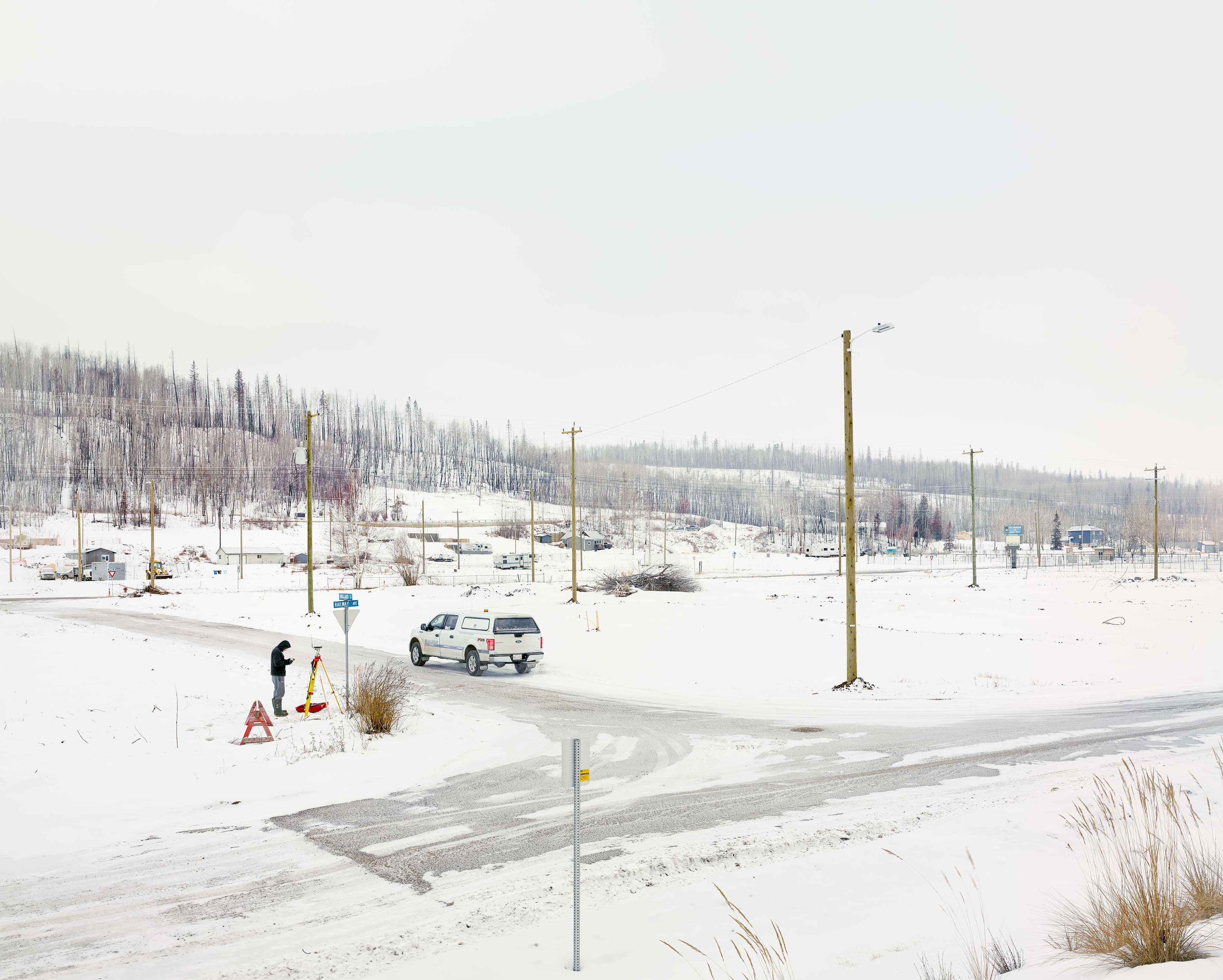
Songs of the Dead
##plugins.themes.immersion.article.figure##

Resumo
Songs of the Dead is a photographic exploration of the aftermath of a devastating fire that impacted the community of Fort McMurray in Alberta Canada on the 3rd of May 2016. Six months after the fire, stimulated by media coverage and reflecting on the discourse surrounding dispossession and the environment, the project commenced at ground level with support of a Royal Photographic Society Environmental Awareness Bursary in a region inhabited by Anishinaabe1 located within Treaty 8 Territory, the traditional lands of the Cree, Dene and unceded territory of the Métis.
The visual essay presented here is centred in the wake of a major fire event, however, it is also about human law and ecosystems. By traversing discussions on ethics within documentary photography and briefly exploring the history Aftermath of this medium, we argue how photography can better address socio-ecological issues within climate change through poetics. We offer a way of resisting the norms of documentary photography, resulting from subject and process-driven methods.
Cover image: The Last Man - photo by Alan McFetridge
Referências
- Belleville, Genevieve, et al. 2021. “Psychological Symptoms Among Evacuees From the 2016 Fort McMurray Wildfires: A Population-Based Survey One Year Later.” Frontiers in Public Health May 4 (2021): 1. doi: 10.3389/fpubh.2021.655357.
- Bowman, David. 2020. “Adaptive thinking and the global fire crisis.” EGU - General Assembly 2020. https://doi. org/10.5194/egusphere-egu2020-20957.
- Canadian Government. 2020. “What are the oil sands.” What are the oil sands? https://www.nrcan.gc.ca/our-naturalresources/ energy-sources-distribution/fossil-fuels/crude-oil/what-are-oil-sands/18089.
- Cotter, John. 2016. “Alberta declares state of emergency as firefighters struggle to save Fort McMurray.” The Toronto Star, May 4, 2016. https://www.thestar.com/news/canada/2016/05/04/hot-dry-winds-threaten-to-worsen-hellish-fortmcmurray- wildfire-today.html.
- Dostoyevsky, Fyodor. 2020. The House of the Dead. N.p.: Naxos AudioBooks. https://www.audible.co.uk/pd/The-Houseof- the-Dead-Audiobook/1781982600.
- Fiola, Chantal, and Rick Monture. 2015. Rekindling the Sacred Fire: Métis Ancestry and Anishinaabe Spirituality. N.p.: University of Manitoba Press.
- Flannigan, M. D., and et al. 2011. “Scale-dependent controls on the area burned in the boreal forest of Canada, 1980–2005.” Ecological Applications 21 (3): 789-805. 10.2307/23021627.
- Forsyth, Huhana. 2018. “An identity as Pākehā. AlterNative: An International Journal of Indigenous Peoples.” AlterNative: An International Journal of Indigenous Peoples 14 (1): 73 - 80. https://journals.sagepub.com/doi/10.1177/1177180117752479.
- Gammage, Bill. 2012. The Biggest Estate on Earth: How Aborigines Made Australia. N.p.: Allen & Unwin.
- Huberman, Irwin. 2001. The Place We Call Home : a History of Fort McMurray, as Its People Remember, 1778 - 1980. N.p.: Historical Book Society of Fort McMurray.
- Keough, Beth. 2015. “Planning for growth in a natural resource boomtown: challenges for urban planners in Fort McMurray, Alberta.” Urban Geography 36 (8): 1169 -1196. https://doi.org/10.1080/02723638.2015.1049482.
- Little Bear, Leroy. 2000. “TRADITIONAL KNOWLEDGE AND HUMANITIES: A PERSPECTIVE BY A BLACKFOOT.” https:// www.researchgate.net/publication/284054438_Jagged_worldviews_colliding_In_M_Battiste_Ed/stats.
- McGee, Tara K. 2019. “Preparedness and Experiences of Evacuees from the 2016 Fort McMurray Horse River Wildfire.” Fire 2 (1): 13. https://doi.org/10.3390/fire2010013.
- Meyerowitz, Joel. 2011. Aftermath - 2011 Edition. N.p.: Phaidon Press.
- Milhollen, Hirst. 1946. “Roger Fenton, Photographer of the Crimean War.” Quarterly Journal of Current Acquisitions 3 (4): 10-12. http://www.jstor.org/stable/29780435.
- Milligan, Christine, and Janine Willes. 2010. “Landscapes of Care.” Progress in Human Geography. https://journals.sagepub. com/doi/10.1177/0309132510364556.
- Musée Magazine. 2011. “ISRAEL AND PALESTINE BY THOMAS STRUTH AT MARIAN GOODMAN GALLERY.” Musée Magazine. https://museemagazine.com/culture/art-2/features/thomas-struth-at-marian-goodman-gallery-2.
- Nietzsche, Friedrich. 1892. Thus Spake Zarathustra: A Book for All and None. 2021 Penguin Audio.
- Robinne, F., Parisien, M.-A. et Flannigan, M.D. 2016. “Anthropogenic influence on wildfire activity in Alberta, Canada.” International Journal of Wildland Fire 25, no. 11 (January). 10.1071/WF16058.
- Rosler, Martha. 1990. ‘In, Around, and Afterthoughts (On Documentary Photography)’. In The Contest of Meaning: Critical Histories of Photography, edited by Richard Bolton. Cambridge, MA: MIT Press.
- Salgado, S. 2021. “Gulf War aftermath.” Legion Magazine. https://legionmagazine.com/en/gulf-war-aftermath/.
- Scott, A.C., D.M.J.S Bowman, W.J. Bond, S.J. Pyne, and M.E. Alexander. 2014. Fire on Earth: An Introduction. Hoboken, New Jersey: Wiley Blackwell.
- Scott, Andrew, David Bowman, William Bond, Stephen Pyne, and Martin Alexander. 2014. Fire on Earth: An Introduction.
- Shields, Rob. 2012. “Feral suburbs: Cultural topologies of social reproduction, Fort McMurray, Canada.” International Journal of Cultural Studies 15 (3): 206 -214. https://journals.sagepub.com/doi/full/10.1177/1367877911433743.
- Steffen, Will. 2016. “Trajectories of the Earth System in the Anthropocene.” Earth, Atmospheric, and Planetary Sciences 351, no. 6269 (January). 10.1126/science.aad2622.
- Stocks, B.J., and R. Servranckx. 2022. “Understanding the critical elements of the pyrocumulonimbus storm sparked by high-intensity wildland fire.” Nature, 1-7. https://doi.org/10.1038/s43247-022-00566-8.
- Stoknes, Per Espen. 2014. “Rethinking climate communications and the “psychological climate paradox.”” Energy Research & Social Science, 161-179. https://doi.org/10.1016/j.erss.2014.03.007.
- Waters, Colin. 2016. “The Anthropocene is functionally and stratigraphically distinct from the Holocene.” Science 351, no. 6269 (January). 10.1126/science.aad2622.
- Weszkalnys, G. 2016. “A doubtful hope: resource affect in a future oil economy.” Journal of the Royal Anthropological Institute 36 (39): 127-146. https://doi.org/10.1111/1467-9655.12397.